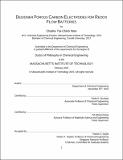Designer Porous Carbon Electrodes for Redox Flow Batteries
Author(s)
Wan, Charles Tai-Chieh
DownloadThesis PDF (20.22Mb)
Advisor
Brushett, Fikile R.
Chiang, Yet-Ming
Terms of use
Metadata
Show full item recordAbstract
Porous carbon electrodes play an important role in electrochemical systems by providing electrocatalytic sites to facilitate faradaic reactions, distributing reactants and products, and conducting electrons and heat. The microstructure and surface chemistry of such electrodes are of particular relevance to redox flow batteries (RFBs), as, during operation, dissolved active species are forced through the porous media and react on its internal surfaces. RFBs hold promise for long duration energy storage due to their decoupling of energy and power, long service life, and scalability. However, contemporary RFBs are prohibitively expensive, incentivizing further cost reduction. Decreasing reactor cost by increasing power output is a promising chemistry-agnostic approach to bridging the economic gap. While commercial electrodes are functional, their properties are suboptimal for existent and emerging RFB chemistries. This thesis seeks to advance porous electrodes and electrocatalysts with property profiles tailored for RFBs through three interrelated approaches.
The first section introduces non-solvent induced phase separation (NIPS) as a facile and versatile method to engineer interconnected porous microstructures with property sets unattainable in present-day commercial fiber-based electrodes. Combining spectroscopic characterization and fluid dynamic measurements with electrochemical evaluation with common aqueous redox couples (i.e., Fe²⁺⸍³⁺, V²⁺⸍³⁺, and VO²⁺/VO₂⁺), structure-function relations are developed for RFB electrodes. By tuning the synthesis protocol, the electrochemically accessible surface area, permeability, and through-plane porosity distribution can be systematically varied, offering new pathways to high-performance materials.
The second section advances the interfacial engineering of electrode surfaces. A synthetic method to generate dense and planar carbon films enables opportunities to extract fundamental rate constants on bottom-up designed materials using conventional electroanalytical approaches. Next, I show that oxidative chemical vapor deposition of nanometric poly(3,4-ethylenedioxythiophene) coatings onto porous electrodes enhance electrochemical performance (i.e., Fe²⁺⸍³⁺), illuminating pathways for tailorable surfaces. Finally, I show how biomass from refuse streams such as food waste and wood byproducts can be used to obtain high surface-area electrocatalysts with desired surface functionalities without post-processing, suggesting next-generation electrode materials through low-cost and sustainable feedstocks.
The third section explores mathematical frameworks to quantify the effectiveness factor of high surface electrocatalysts as functions of particle and reactant properties, applying both Tafel and Butler-Volmer kinetic descriptions to reaction-diffusion processes within a porous sphere. From this analysis, I identify design principles for electrocatalyst sizing based on desired utilization efficiency and find markedly lower catalyst utilization for micron-scale porous electrocatalysts often employed to enhance aqueous RFB performance, motivating the need for hierarchical structured materials to mitigate diffusional pore-scale losses. This treatment is then integrated into a catalyst layer model for polymer electrolyte fuel cell cathodes to investigate the effect of nanoscale ohmics arising in porous-carbon-supported platinum catalysts used for oxygen reduction. While RFBs are the primary focus of this thesis, the methods and findings described are generalizable to convection-driven electrochemical reactors that benefit from engineered transport layers.
Date issued
2023-02Department
Massachusetts Institute of Technology. Department of Chemical EngineeringPublisher
Massachusetts Institute of Technology